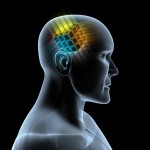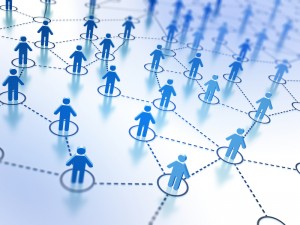Consciousness Is A Verb

It’s not in here.
We live in an individualistic culture and I wonder if that doesn’t bias our understanding of how we behave and think. For instance, we view humans as self-contained and self-sufficient units. There’s a clear boundary between one human and another. Similarly, there’s a clear boundary between each individual and the environment around us. We are separate from each other and from the world.
But what if that’s not the case? What if humans are entangled with each other in much the same way that quantum particles are entangled? Mirror neurons are still somewhat mysterious but what if they allow us to entangle our thoughts with those of other people? Similarly, we’ve learned in the recent past that we think with our bodies as much as our brains. What if our thinking actually extends beyond our bodies and interacts with other thoughts?
Similarly, what if the environment is not separate from us but part of us? What if the environment shapes us much like a river shapes a stone? In a sense, it would mean that we’re not entities but processes. We’re not things but actions. The Buddhists might be right: impermanence is the very essence of our being.
If these things are true, it may give us a key to understanding consciousness. Defining consciousness is known as the “hard problem”. Neuroscientists often phrase the question simply: “What is consciousness?” What if that’s the wrong question? The question implies that consciousness is a thing. It also suggests that consciousness exists somewhere, most likely in the brain. But what if consciousness is not a thing but an action? What if it’s something we do as we interact with the environment? What if we’re swimming in consciousness?
You may have guessed by now that I’ve been reading the works of the philosopher, Alva Noë. (See here and here). Noë studies perception and consciousness and tries to understand how they are entangled. Noë states flatly that, “Consciousness is not something that happens in us. It is something we do.”
Noë goes on to compare consciousness to a dancer, who is influenced by myriad external factors, including the music, the dance floor, and her partner. Dancing is not within the dancer. Noë writes that, “The idea that the dance is a state of us, inside of us, or something that happens in us is crazy. Our ability to dance depends on all kinds of things going on inside of us, but that we are dancing is fundamentally an attunement to the world around us.” Similarly, Noë suggests, consciousness is not within us, rather it is “…a way of being part of a larger process.”
Noë similarly argues that consciousness is not located in a given place. The analogy is life itself. If we look at other people, we can tell that they’re alive. But where is life located in them? We quickly realize that we don’t think of life as a thing that is located in a certain place. Life is not a thing but a dynamic. Noë argues that the same is true of consciousness.
Noë also suggests that cognitive scientists are pursuing the wrong analogy – the computer. This “distinctively nonbiological approach” converts consciousness into a mere computational function that is “…very much divorced from the active life of the animal.” The active life – and engagement with the world around us – creates consciousness in a way that a “brain in a vat” could never do.
What’s it all mean? We’re looking for consciousness in all the wrong places. As Noë concludes, “…the idea that you are your brain or that the brain alone is sufficient for consciousness is really just a mantra, and … there is no reason to believe it.”
The United States of Mind

Each cell has its own agenda.
We didn’t really understand the human heart until the mid 17th century, when engineers developed vacuum pumps to move water out of mines. Anatomists realized that such pumps provided an excellent analogy for what the heart does and how it does it. As technology advanced, we used it to learn about our own biology.
In the 20th century, with the advent of the digital computer, we humans reached a similar conclusion-by-analogy: computers show us how our brains work. In the computer, we see elementary logic, various switches flipping on and off, and memory cells that hold information in its most elemental form – binary digits. Perhaps our brains work the same way.
The brain-as-computer analogy has never been perfect, however. The computer, for instance, has a central processing unit (CPU) that manages pretty much everything. The brain doesn’t appear to have an analogous organ. Rather, human thinking seems to be diffuse and decentralized. Indeed, much of our thinking seems to occur outside our brain; the mind is, apparently, much bigger than the brain. Similarly, we can precisely locate a “memory” in a computer. No such luck with a human brain. Memories are elusive and difficult to pinpoint.
Further, the brain is plastic in ways that computers are not. For instance, a good chunk of our brainpower is given over to visual processing. If I go blind, however, my brain can redeploy that processing power to other tasks. The brain can analyze its own limitations and change its functions in ways that computers can’t.
Given the shortcomings of the brain-as-computer analogy, perhaps it’s time to propose a new analogy. Having absorbed a healthy dose of Daniel Dennett (see here and here), I’d like to propose a simple alternative: the brain functions much like the United Sates of America.
That may sound bizarre but let’s go through the reasoning. First, Dennett points out that brain cells, as living organisms, can have their own agendas in ways that silicon cannot. Yes, brain cells may switch on and off as electricity pulses through them, but they could conceivably do other things as well. Perhaps they can plot and plan. Perhaps they can cooperate – or collude, depending on how you look at it. Perhaps they can aim to do things that are in their best interests, as opposed to the interests of the overall organism.
Second, Dennet notes that all biological creatures descended from single-celled organisms. Once upon a time, single-cell organisms were free to do as they pleased. Some chose to associate with similar organisms to form multi-celled organisms. In doing so, cells started to specialize and create communities with much greater potential. However, they also gave up some of their primordial freedom. They worked not just for themselves but also for the organism as a whole. Perhaps our cells have some “memory” of that primordial freedom and some desire to return to it. Perhaps some of our cells just want to go feral.
And how is this like the United States? The original colonies were free to do as they pleased. When they joined together, they gave up some freedom and created a community with much greater potential. We assume that each state works for the good of the union. But each state also has strong incentives to work for its own good, even if doing so undermines the union. Similarly, each state has a “memory” of its primordial freedom and an inchoate desire to return there. Indeed, states’ rights are jealously guarded.
Let’s assume, for a moment, that we have a microscope as big as the solar system. When we examine the United States, we see 50 cells. Each cell seems to be similar in function and process. We might assume that they always function for the good of the whole. But when we look closer, we see that each cell has its own agenda. Some cells (Texas?) may want to go feral to recapture their primordial freedom. Other cells are jockeying for position and advantage. Some are forming alliances and coalitions with like-minded cells to accomplish their aims. Red cells seem to have different values and processes than blue cells.
Could our brains really be as chaotic as the good old USA? It’s possible. If nothing else, such an analogy frees up our thinking. We’re no longer in a silicon straitjacket. We recognize the possibility that living cells may have complex agendas. We start to see possibilities that we were previously blind to. I would write more but I suspect that some of my neurons have just gone feral.